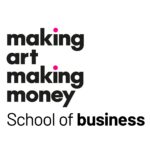Artists don't get paid just to show their art; they must sell it.
Art Schools-Setting Up Students To Fail
- You will be sold on the dream of having a successful “career” as a fine artist, even though successful careers don’t actually exist for fine artists. Fine artists must sell their art so they own businesses.
- Your art professors can not teach you how to sell your art and they may shame you for even asking how. So you will graduate with an internal conflict about making art and making money.
- You will pay much more for the “privilege” of a fine art education from prestigious art schools yet you’ll have far fewer scholarships available to you resulting in significant debt. You’ll graduate without marketable skills to repay that debt which could place your future in peril.
Art students are taught to focus on finding their creative voice and develop their artistic skills so that “one day,” they can have a successful “career” as artists. However, the notion of having a successful “career” as a fine artist is an ill-defined, misguided with an impossible definition of success.
Art school professors define their success by paying to apply to gain acceptance into select juried shows. The purpose of these juried shows is to exhibit art; it is not to sell art. In academic circles, the common belief is that money taints art rendering it impure creative expression.
Artists don’t get paid just to show their art; they must sell it.
It is a common fantasy to think that there are wealthy patrons who pay for an artist’s creative indulgence for nothing in return. No matter who you are or what you do, you are paid based upon the value you deliver. Artists are not exempt from this universal economic law.
When art students bravely ask their art professors, “How can I make a living as an artist?” Art professors will offer one of three typical responses:
- “If you can, you’ll need to find a job teaching art.”
- “You’ll need to marry well.”
- “Focus on making great art so that it can sell itself. You shouldn’t be concerned with money.”
Who isn’t concerned about money? Art schools are certainly concerned about money.
Did you know that it costs more to attend one of the top 42 art and design schools in North America than it does to attend one of the top Ivy League schools?
The annual tuition to attend the Rhode Island School of Design is currently $78,540, that’s 19% more expensive than Harvard Law School, which is now $65,875.
Unlike the Ivy League schools, even the most prestigious art school endowments are underfunded because they do not receive much in the way of alumni donations. Therefore, art schools can not offer many scholarships, so art students have more debt than most.
Fine art school students are paying dearly for their education by taking on inescapable student loan and credit card debt.
The sad irony is that an expensive investment in an art school education will leave a fine art student emotionally and intellectually conflicted about making money from their art. And without the skills to repay their debt or make a living with their art.
The U.S. Department of Education is scrutinizing even some of the most prestigious art and design schools because their student loan default rate is so high.
One art school president confessed privately that despite the reputation of many prestigious art schools, their academic credentials are in jeopardy.
Art schools are selling the dream of successful fine art “careers”, however, there are no jobs for fine artists. With no jobs, there are no careers.
Successful artists sell their art, and selling art is a business but most artists don’t think of themselves as business owners.The IRS thinks otherwise, and it requires artists who do sell their art to file a business profit and loss statement, or Schedule C, for their small business.
The heartbreaking financial repercussions of earning an expensive fine art degree are very real. Two fine art graduates from the San Francisco Academy of Art University shared their plights.
- It took my intern seven years to earn a bachelor’s degree in fine art illustration from the San Francisco Academy of Art University. It cost her over $200,000 in student loan and credit card debt. The $3500 course entitled “Designing Careers” left her with no career direction and little hope. To make matters worse, her father had just been laid off and her mother had just passed away.
- A young man who reached out to me in hopes of joining my program recently graduated from the San Francisco Academy of Art University with $179,000 worth of student loan debt and no job in sight. Now he is a full-time caretaker for his ailing father. He no longer has the money, or the time and energy to make art, nevermind learn how to sell his art. He is terrified about his future.
- I was invited to participate in a panel of professional artists at UC Berkeley. One young art major asked us how she was going to earn a living as an artist after graduating. The tenured art school professor on the panel advised her, “Don’t worry about it. Everything has a way of working out.” This is easy to say if you are in the rare position of being an art professor with tenure.
Even if an artist rebels against academia’s twisted definition of success and decides to sell their art, they will be labeled a “sell-out.”
A survey of my students revealed that most who graduated with a fine art degree stop making art one or two years after art school because they needed to make money more than they need to make art.
Art professors are hard-working and dedicated people; this is not an indictment against them. Unfortunately, they do not possess the vital skills needed to sell their own art, so how could they possibly teach students the skills that they need to succeed?
The reality is, a plan to sell your art, without a plan, is a plan to sell no art.
Is it easy to sell your art? We all know that it is not. Is it possible? Absolutely
Apply to enroll in the Making Art Making Money program. Unlike art school, you’ll graduate once you’ve earned back your tuition investment, at a minimum, through the sale of your art during your final project.

Ann Rea, Fine Artist & Mentor
Ann Rea is a San Francisco-based fine artist. She created Making Art Making Money™, the leading and most reputable business program for fine artists since 2005. Rea’s art and business savvy have been featured on ABC, HGTV, Creative Live, The Good Life Project, in the book Career Renegade by Jonathan Fields, the San Francisco Chronicle, Art Business News, Fortune, and Inc. Magazines. Rea’s artistic talent was commended by her mentor, art icon Wayne Thiebaud.

My first semester at Massachusetts College of Art, in September 1969, was begun with an assembly, at which our dean of students told us that we must resign ourselves to a life of poverty. Those words felt like being struck by a bullet. I had just started at a school that everyone in my growing up years had said was the best. And now, here was the great betrayal. At age 67 I am strongly looking to invest in this course with Ann Rea. I refuse to put up with any more of the negative thinking. Practical steps and plans make great sense.